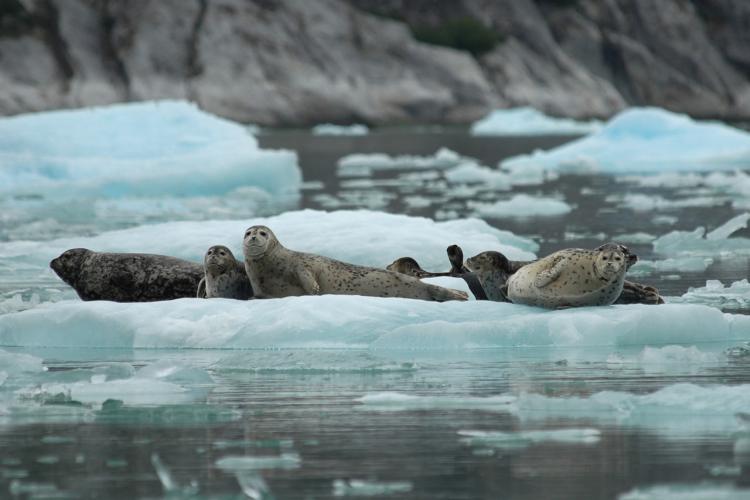Julie Speegle, (907)586-7032 (office), (907)321-7032 (cell)
NOAA Fisheries is announcing new, voluntary approach guidelines for vessels in Alaska tidewater glacial fjords to minimize disturbance to harbor seals in sensitive nursery habitat.
"These guidelines are intended to provide additional protection for harbor seals, while continuing to offer high-quality glacial viewing opportunities to visitors and locals alike," said Jon Kurland, Assistant Regional Administrator for Protected Resources in NOAA Fisheries' Alaska Region.
Tidewater glacier areas provide essential habitat for harbor seals in Alaska. Such areas are only available to seals in southcentral and southeast Alaska, where there are fewer than two dozen ice-filled inlets. In one area alone — Icy Bay near Yakutat — a thousand pups are born each year. With a count of over 5,000 harbor seals, Icy Bay may represent the largest aggregation of harbor seals in the world.
Recent studies published by scientists at NOAA's Alaska Fisheries Science Center (AFSC) conclude that the agency's previous voluntary guidelines to avoid approaching harbor seals within 100 yards are inadequate to protect seals from disturbance. One study found that seals approached by ships at 100 meters (about 100 yards) can be 25 times more likely to flush into the water than seals approached at 500 meters. More than 75% of the seals were observed to flush before vessels reached the previous minimum approach distance. When seals are flushed from ice floes, pups are at increased risk from cold temperature stress. Flushing of mother seals increases the risk of pups becoming separated and disrupting nursing during a stage when pups rely entirely on their mothers for nutrition, to build critical fat reserves, and for protection. A study published by NOAA scientists in July 2015 suggests that a single ship in one glacial fjord may cause up to 14% of the local seal population (11% of pups) to flush into the water. With multiple vessels visiting daily, overall disturbance in these seal habitats is likely higher.
"With vessel traffic in these pupping areas rising dramatically since the 1980s, and with evidence seals are regularly flushed from the ice during the tour season, it seems existing approach guidelines aren't having the intended effect of protecting seals," said John Jansen, AFSC's lead investigator of glacial seals.
A study published by Alaska Department of Fish and Game scientists in May 2015 found that the highest probability of vessels flushing seals in the water occurred midday. To reduce disturbance, they recommend vessels visit in the morning and early evening.
NOAA Fisheries has worked with members of the tourism industry to develop meaningful, voluntary guidelines that reflect the latest scientific findings on this topic, while also implementing workable solutions for vessel operators who rely on tidewater glacier viewing as a highlight of their tours and thus a source of revenue. These groups may include all facets of the tour industry, from day boats to charter vessels to the cruise ship industry.
The new guidelines apply to all vessel types in all glacial areas year-round. The guidelines recommend vessel operators:
- Keep 500 yards (~1/4 mile) from all seals without compromising safe navigation
- Practice no wake, avoid abrupt changes in course or engine pitch, and avoid loud noises
- Avoid traveling through waters with greater than 50% ice cover
- Target visits during early morning and evening hours when fewer seals are hauled out
At two specific sites where high vessel traffic coincides with large numbers of pups, additional seasonal and area restrictions are advised to provide additional protection while mothers are rearing pups. These particular voluntary actions apply to vessels in Disenchantment Bay and Tracy Arm from May 15-June 30.
The guidelines are voluntary but strongly recommended to help prevent vessels from violating the Marine Mammal Protection Act. Any activity which disrupts normal seal behavior constitutes a "take" under the MMPA, which is prohibited.
NOAA Fisheries and partners will monitor these glacial tidewater habitats to determine if these voluntary approach guidelines are providing a sufficient level of protection for seals.



